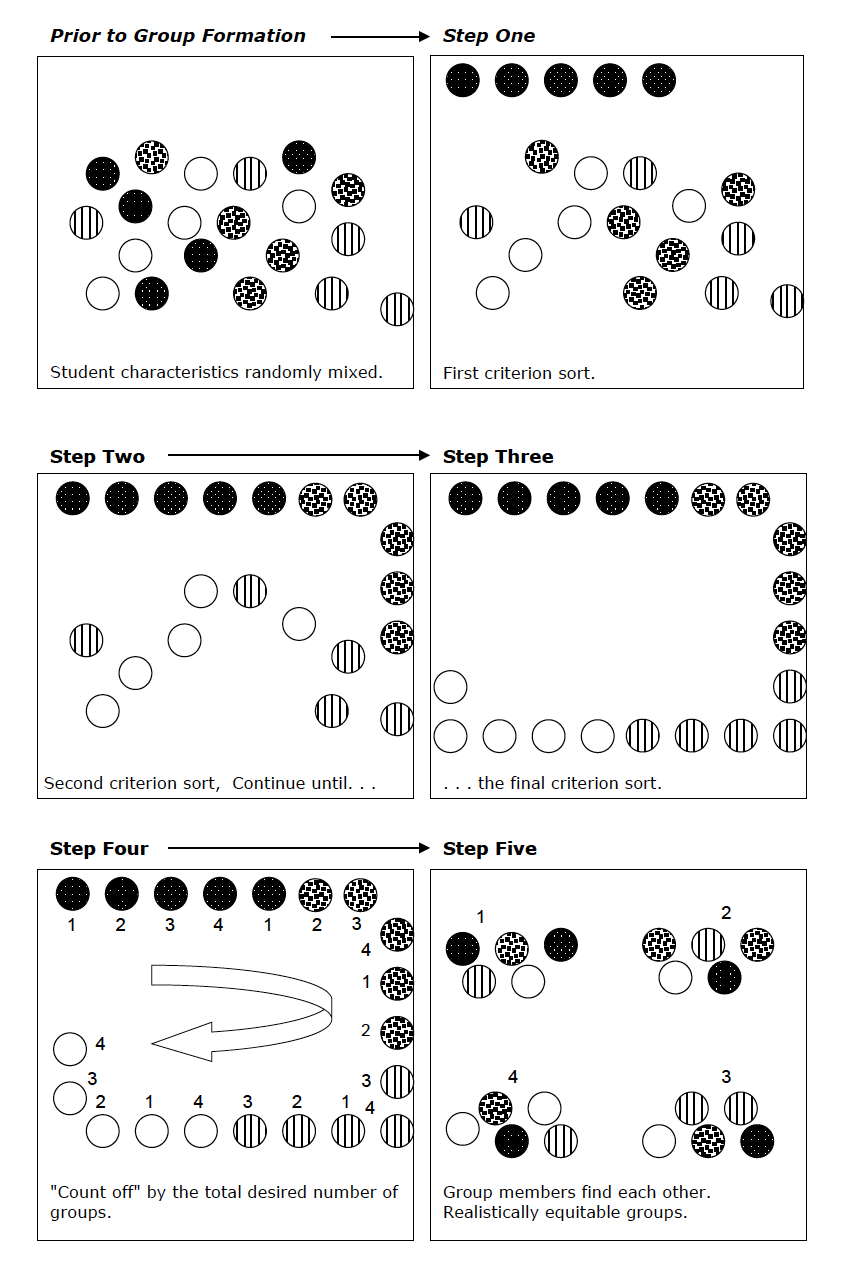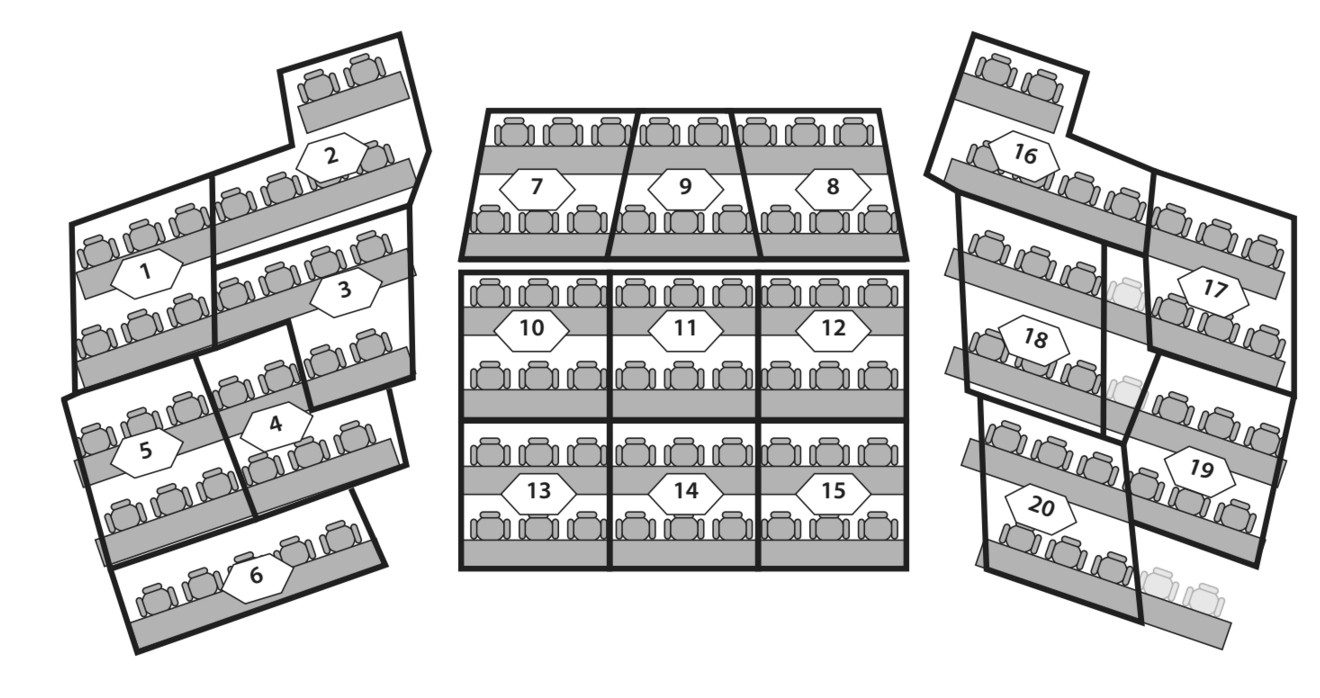Forming Teams
In this phase you need to:
- Decide on team composition requirements
- Create student sorting questions
- Select a team formation plan
- Be ready to respond to student challenges
Optional Reading
- Assigning Students to Groups for Engineering Design Projects: A Comparison of Five Methods by Brickell, J.L., Porter, D.B., Reynolds, M.F., Cosgrove, R.D.
Team Composition for TBL
- Teams should be five to seven students.
- Teams should be teacher and criterion created.
- Teams should be diverse.
- Team need to be permanent.
Building Questions to Sort Students
1) Decide Your Sorting Questions
Ahead of time, decide what characteristics would make the course easier or more difficult for a student. For example, previous degrees, work experience, comfort with a certain subject area (stats, math, writing, science, etc.), a specific kind of skill, being from a different culture, having a different native language – anything that might make the course experience easier or more difficult.
2) Prioritize Your Sorting Questions
List these characteristics in order of importance, mixing the “benefit” and “detriment” characteristics together into one list, with the most important characteristic at the top. You must prioritize because many students will have more than one characteristic on your list (e.g., a professional in the field who grew up speaking a different language). Phrase these characteristics carefully, to avoid embarrassing any one group of students.
For example, one anthropology teacher uses “did not grow up in Oregon or any of the immediately surrounding states” instead of “speaks English as a second language.”
Small Classroom Team Formation
- I want everyone with work experience at the front of the line.
- With the remaining students not yet lined up, who has a previous degree? Please line up behind them.
- With the remaining students not yet lined up, who has lived overseas? Please line up behind them.
- Everyone else line up at the end of the line.
Students will often fit into multiple categories, but you will begin the line with the categories that are most important for team success. This is not an exact process and doesn’t need to be. You are creating diverse teams with a range of talents. The questions and criteria you choose to use to order the line depends on who your students are and what assets and liability you want to distribute across all teams. Once the students are in the line, you do the simple math of how big the class is and how many teams you can have with five to seven students on each team. Once you know the number of teams you want, you simply count off the teams.
For example, in a class with 42 students, you have decided to have 7 teams with 6 students on each team. Now you would count off from the start of the line: 1, 2, 3, 4, 5, 6, 7, 1, 2, 3, 4, 5, 6, 7 until you run out of students. Don’t worry about being exact. The literature shows that randomly-formed teams perform almost as well as teacher-formed teams. So there’s no need to obsess over every last student getting into the exact right group. You might keep track of your most important sort criteria and do a few last-minute shuffles that might be necessary to get teams of equal strength. As an example, in a foundation engineering course, we might shuffle a few people at the end of the team formation process to ensure that each team has both a geological engineer and someone that is good with math.
 This simple procedure has been used with great success in TBL classrooms for over 30 years. It might feel like it takes up valuable class time, but students really seem to enjoy the team formation process, and it is important that students know the teams were formed fairly and transparently. Once teams are formed, students will sit back down with their team, and we will give them a few minutes to do introductions inside their teams. Some teachers will at this point also ask the teams to come up with a team name.
This simple procedure has been used with great success in TBL classrooms for over 30 years. It might feel like it takes up valuable class time, but students really seem to enjoy the team formation process, and it is important that students know the teams were formed fairly and transparently. Once teams are formed, students will sit back down with their team, and we will give them a few minutes to do introductions inside their teams. Some teachers will at this point also ask the teams to come up with a team name.
Large Classroom Team Formation
For example, I download the survey/quiz results for the 180 students in my course. Then I build a sort based on the column order that I feel is the most important, first sorting on most important criteria, then on second most important, then on third…etc. This kind of sorting is extremely simple in Excel™. You can sort by multiple columns by simply using the + control on the Excel™ sort dialog box and adding columns in the order from most to least important. Below is a image of the sorting dialog box from Excel™. In this example, I first sort on work experience, then previous degree and finally gender. This lets you in one simple step do a sort that is similar to ordering the line of students in the classroom.
Once sorting is complete, I simply count off on the Excel™ table. In the case of this course of 180 students, I may decide to do 30 teams of 6 students. Next, I would count down the sorted Excel™ results mbering the students 1, 2, 3, and up to 30, and then repeating the 1 to 30 numbering as needed for the entire class list. The list is then sorted into alphabetical order by student name, and the resulting roster of teams 1-30 is posted to the LMS.
When using any team formation method that isn’t done in front of the students, you should inform them of the procedure you used to form the teams. Students need to feel that the teams were fairly created.
Students will need to know where to find their team in large classrooms. To help with this, we create classroom maps that show exactly where each team should sit (see figure below). We post this along with the team assignments in the course website or LMS before the first Readiness Assurance test. We also display this map on the classroom screen when students are arriving at the first Readiness Assurance test, so they can find the correct place to sit. In large classes, we have students sit with their teams right from the start. This prevents any disruption at the end of the individual Readiness Assurance Test from students changing seats.
There is one interesting mistake in the above diagram. Can you spot it?
The diagram is built from the instructor point of view. When displayed in classroom, students need to translate in their head left to right and top to bottom to actually locate their team. We now build these class maps with the students in mind.
Frequently Asked Questions
How should I form teams?
Teams should be formed by instructor. You must resist student preference for student selected teams. The literature clearly shows that in the long term, criterion formed teams outperform student selected teams. When you create team you need to think about the student assets that you want to spread across all teams. Maybe each team should have someone with work experience, or someone who has lived overseas, or someone who speaks a second language. You need to think about who your students are and what each team will need to have to be successful. Information on the logistics of forming teams in small classes can be found here. Information on the logistics offorming teams in large classes can be found here.
Brickell, J.L., Porter, D.B., Reynolds, M.F., Cosgrove, R.D., (1994) Assigning Students to Groups for Engineering Design Projects: A Comparison of Five Methods. Journal of Engineering Education, 7:259-262
Can I use smaller teams of 3-4?
Team should be 5-7, really! This is counter-intuitive to most teachers experiences using groups where large teams mean some should can hide and do no work (known as social loafing). These bigger teams work when you ask the right kind of questions. When team tasks are product based, small teams are necessary to control social loafing. When team tasks are messy, authentic decisions, big teams work! The teams actually need the intellectual horsepower to solve these big teams.
When I conducted interviews for my book, I always asked question about team size and have your team always been that 5-7. I got a very consistent response. People were initially reluctant to use big teams, but on reflection pretty much said the same thing – if I had trouble with a team,it was a smaller team. I now believe in and use the bigger teams.
Should I mix the teams up periodically?
NO – when we first create groups of students there is considerable energy spent on “social overhead” as students work with other, begin to trust each other, recognize how to work together they cohere into a much more powerful team entity that spend a greater portion of their effort on task focused work. Mixing teams resets teams into groups and they have to cohere all over again .he literature points to 10-14 hours of task focused work to create high levels of team cohesion. The Readiness Assurance Process and Application Activities all foster team cohesion.
How do I handle students that insist on picking their own teams?
SAY NO – there are a few nice ways to handle this. First and foremost, have your words and rationales ready.
I refer students to: Brickell, J.L., Porter, D.B., Reynolds, M.F., Cosgrove, R.D., (1994) Assigning Students to Groups for Engineering Design Projects: A Comparison of Five Methods. Journal of Engineering Education, 7:259-262. I ask them to write a half page analysis of why the paper is wrong in recommending teacher formed groups. If I accept their arguments, I tell them I will let them self-select. No student has ever taken me up on this.
Laura Madson has a nice story she tells. There is a boyfriend and girlfriend on your team, they break up mid-semester – do want to be on that team?
Say NO to self-selection. Be ready for this question and stand your ground.
How do I resolve conflicts among team members?
With Team-Based Learning there often isn’t the kinds of conflicts you see with other forms of group work. Having teams focus on decisions and needing the defend why they made a particular decision really changes things. Give a well functioning TBL team and bad assignment and you will get dysfunction and conflict, but ask the right kinds of questions (decisions) the right way (4S) and there usually isn’t any conflicts that need managing by the teacher.

